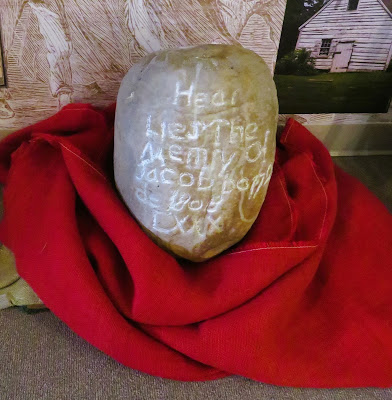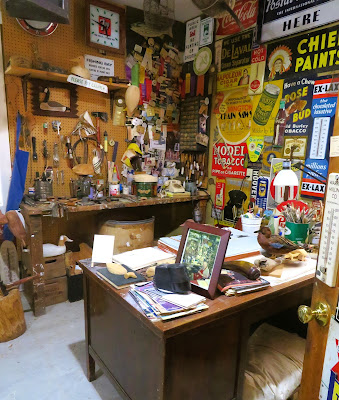…continuing with our exploration of the Delmarva Peninsula this past September. I didn’t have any plans originally to visit Dorchester County or Cambridge. But on a whim we changed the plans a bit. We did have the better part of 3 days in the area so why not look around a bit?!
As we
wandered around Cambridge Maryland we ran across the Heritage Museum and
Gardens of Dorchester. It was open and
as it turned out, we pretty much had the place to ourselves excepting staff
members who were studying or doing research.
The museum consist of the Neild Museum, opened in 1980, and the Polly
Robbins Heritage Center, which was opened in 2007.
Overall,
this museum is what I term an interesting accumulation of local historic
objects. The focus here was an
amalgamation of local history, the canning industry, farming, everyday items
used by locals, logging, hunting and trapping, marine related businesses, the
War of 1812, Native Americans and more.
These
days many of us have a printer in our homes that works through our computer or
smart phone. When I taught school, I
remember those old smelly mimeograph machines. This multigraph machine predates my experience
by quite a bit. This is freestanding Model
#60 manufactured by the American Multigraph Company in Cleveland Ohio. They made this model from roughly 1902 until
1930.
Some avid
collector spent quite a bit of effort putting together this collection of commemorative
plates…all about churches in Maryland.
This
looks older than it is. It is a 1963
Dudley Olympia Automatic baseball pitching machine. Actually, this is appropriate for Cambridge
as they hosted a minor league baseball team, part of the Eastern Shore League,
on 3 occasions, 1922 – 1928, 1937 – 1941 and 1946 – 1949.
This
display contains a wide variety of items.
Then range from a pork sausage tin, to a burlap Planter’s Peanuts bag,
through a couple of squeeze boxes/small accordions to a Boraxo tin. Of special note is the Ukelin at the right
center of the photo. Ukelins were
popular in the USA in the 1920s. It’s a bowed
psaltery with zither strings. Its name
was derived from the ukulele and the violin.
I’m sure
that this bit of post office history came from a country general store or some
similar business that served as a post office for a small community. Folks had to come to the store to pick up from their designated slots or
send out/post their mail.
This is a
basket mold. I’d never heard of this device
before but it makes sense. These molds
were created to ensure uniformity and perfection in each basket made.
To be
honest, I’m not sure just how an oyster shucking stand was used. Based on the little photo within the photo, I believe that it held the bucket that the
shucked oysters went into after being shucked on the shucking table…
The first item shown above is a corn sheller. Shelling corn by hand is hard and slow work. The first modern corn sheller was patented in August of 1839. These freestanding, hand-operated machines made life much easier for the farming community.
The
second photo is quite a bit more primitive.
It is a wooden pedestal corn grinder.
It was used to grind the kernels of corn into meal for cooking.
Continuing
with the farm theme, the machine pictured above is a primitive threshing
machine.
This red ball ensconced in an old cart is railroad related. The term “red ball” was used to describe express cargo service. Around 1892, the Santa Fe Railroad began using the term for priority freight and perishables. Such trains and their tracks cleared for their use were marked with red balls like this one.
This
wooden canoe…made from a log by Native Americans…was found in the marsh near
the Blackwater National Wildlife Refuge.
Note the other Native American artifacts shown above the canoe.
This is called
“The Jacob Stone”. It is a gravestone
that was founded many decades ago on land that was part of Shoal Creek Manor at
one time. It apparently marked the final
resting place for a slave. It reads: “Hear
lies the memry of Jacob. bo 1728 de 1808 LXXX”.
This
carving was created by Washington Hammond Skinner, a local carver for
ships. It is said to depict the face of
Mr. Skinner’s last slave. The carving
hung at the entrance to the Skinner farm.
This is
an altar chair from an African American Church that was located on
Applegarth/aka Lower Hooper’s Island.
That island is not accessible nor is it inhabited today. The bridge to the island was destroyed in a
storm back in 1933.
Decoys are a big deal along the eastern shore of the USA. We own one ourselves that we purchased many years ago on one of North Carolina’s Outer Banks islands. In any case, Ronald Rue was a well-known and loved carver of decoys and the second photo shows a recreation of what his workshop looked like. As discovered on the Internet, Mr. Rue’s decoys are quite collectable.
There are
plenty of displays in the museum showing implements and settings reflecting on
life as it was in the early 1900s and before.
I’ve always loved the design and decorative features on old cast iron
stoves.
Moving on
from the museum itself, we wandered around the grounds. It was well past the gardening season so we
just took a look at the other buildings that are part of the museum. They weren’t open at the time…
This is
the former stable from the property of Charles Goldsborough, the former
governor of Maryland in 1818. He lived
in a manor house across Shoal Creek.
Unfortunately the house was demolished in the early 1970s, but this rare
brick stable was saved. It was moved
here in 1987 and then restored to its 1790 appearance. As per the description, inside the stable are
displays including horse-drawn vehicles, tools for blacksmiths, harness-makers,
wheelwrights and wagon builders.
This structure
was originally used as a smokehouse. The
beams inside are smoked and charred.
Gifted to the Historical Society in 1964, it originally stood at Belvoir
Plantation near Cambridge. Over the
subsequent years it was also used for secure, locked storage of household
goods, hams, sugar and other valuables.
Hence, its current name, “Strong House”.
Formerly
the LaGrange House, this home is now called the Meredith House. This Georgian-style home was built ca.
1760. Inside are examples of furniture
from the Federal and Victorian periods, portraits of local people, china,
silver, quilts, clothing and toys. One
room is referred to as the Governor’s Room.
It displays pictures, furniture and other objects from the 7 governors
of Maryland who came from Dorchester County.
My favorite part of this photo is that impressive white ash tree! To learn more about this museum, go to Dorchester County Historical Society, Maryland | United
States (dorchesterhistory.com).
That’s all
for now. Just click on any photo you’d
like to enlarge.
Thanks
for stopping by for a visit…
Take
Care, Big Daddy Dave






















So many interesting stuff in this museum. First sight of that baseball pitching machine, I thought it were a lotto machine :-))
ReplyDeleteI too would spend hours in that museum. Thanks for also including the buildings and especially the ash tree!
ReplyDeleteI museum sure has a bunch of old stuff. you taught school???
ReplyDeleteThanks, Dave, for a thorough and informative tour of a museum I was not familiar with despite our years of living on the eastern shore. The oyster shucking machine was something new to myself as well.
ReplyDelete